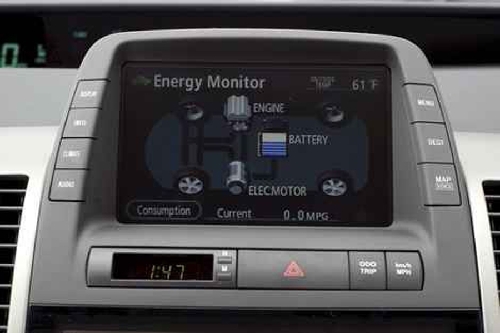‘Regen’ braking stirs interest in hybrid cars
What if the gasoline engine in your car could create some of its own gasoline and put it back into the fuel tank while coasting downhill or stopping at an intersection? And what if this process of creating gasoline also helped slow the car's wheels before coming to a stop?
As farfetched as these ideas sound, they are actually commonplace in hybrid and electric cars' electric motors and battery-storage systems.
Regenerative braking, or "regen," converts mechanical kinetic energy of rolling wheels on a hybrid car into electricity by adding an electric- motor generator and battery pack to the drive train. This conversion process also has the additional effect of electromagnetically slowing the car's wheels as it approaches a stop sign, minimizing the need to use the mechanical hydraulic-braking system.
There are several benefits to these technologies that have been tested and proven in hybrid diesel-electric railroad engines over much of the last century. During the 1930s and 1940s, the U.S. railroad industry made the transition from coal-burning steam locomotive technology to a more efficient diesel-electric hybrid technology by employing innovations originally developed by Thomas Edison's General Electric Co. In today's railroad train, a diesel engine spins an electric generator that creates electricity to drive electric- traction motors and turn the wheels of the locomotive.
An electric-traction motor consists of a combination of wound wires and magnets that are constructed into two parts, a stationary part called the stator and a rotating part called the rotor. When energized by electric energy, the electric-motor-wire windings create powerful opposing magnetic fields between the stator and the rotor that are strong enough to turn the wheels of a railroad engine and pull tons of weighted freight cars behind it.
However, the relationship between a conductive-wire winding and its surrounding magnetic field is a two-way street. High school physics teachers tell us that when a magnet is quickly passed over a conductive wire, it will also create electron movement or electricity that flows along the length of that wire.
The railroad industry discovered that electricity could also be generated in a reverse direction by electric-traction motors, when the wheels of a train were rolling freely without the diesel-powered generator engaged. The resulting electricity could be switched and channeled back to a resistive grid mounted on the roof of the train. The electric motors would convert kinetic energy from the rotating wheels to electricity, and the resistive grid would dissipate electrical energy as heat. Because the resistive grid acted as a load on the motors' electromagnetic fields, rotors would slow down as heat dissipated. This electromagnetic braking system became known as a "dynamic brake," which could be used in conjunction with mechanical air brakes to more easily control a heavy freight train, while coming to a stop or descending a mountain pass.
With the recent development of gasoline-electric hybrid cars and battery-powered electric cars that employ electronic control systems, the addition of a battery pack for storage of electricity added another capability for an electromagnetic-braking system. By electronically switching the motor control circuits to make the battery pack become a load for the electric motor instead of a power source, any electric current generated by the free-spinning electromagnetic fields inside the motor could be fed back to partially recharge the battery pack and extend its range.
Just like the resistive grid in a dynamic-braking system, the battery pack loads the electromagnetic fields of the motor-generator, making them work harder to create electricity. This electrical impedance causes the magnetic field around the rotor to rotate more slowly inside the fixed magnetic field of the stator, while also slowing down the wheels of the car.
Regenerative braking not only recaptures some kinetic energy from the car's spinning wheels to partially recharge the battery pack, it also saves wear and tear on brake shoes, discs and other components of the mechanical braking system.
Depending on road terrain and traffic conditions, a regen system can replenish about 5 to 10 percent of a battery pack's capacity while driving.
Part of the fun of driving a hybrid or electric car is to see how much electric fuel a driver can actually create for free to extend the range of the vehicle, similar to the skills of a rally car road-race driver. Some good driving techniques are to look ahead at upcoming stop signs or traffic lights to gauge the distance, take your foot off the accelerator early and coast as long as possible to the stopping point with regen engaged. This feature can also be enabled on hilly terrain while coasting down an incline.
However, regenerative braking should be employed wisely. Overuse can actually diminish the potential range of a car, if it is engaged all the time by not allowing the electric motor to spin as freely and efficiently while accelerating, climbing a hill, or when cruising on a relatively flat road at a steady speed.
Several new hybrids and electric cars have visual instrument displays on their dashboards that coach drivers on how to use regen for maximum recharge. The 2011 Ford Fusion Hybrid has a SmartGauge display with EcoGuide. EcoGuide uses a video game tutorial to show drivers their regen electricity production in the form of a vine that grows "efficiency leaves." The more electricity the driver creates with regen, the more leaves that are formed on the vine.
The efficient use of regenerative braking is an art, as much as a science, but it can quickly become intuitive as drivers learn how to harmonize their skills to changing road conditions, while also creating their own fuel at the same time.
Stan Hanel has worked in the electronics industry for more than 30 years and is a long-time member of the Electric Auto Association and the Las Vegas Electric Vehicle Association. Hanel writes and edits for EAA's "Current Events" and LVEVA's "Watts Happening" newsletters. Contact him at stanhanel@aol.com.















